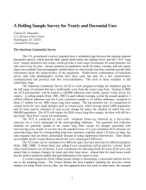A Rolling Sample Survey for Yearly and Decennial Uses
A Rolling Sample Survey for Yearly and Decennial Uses
The U.S. government’s survey programs have a substantial gap between the ongoing national household surveys, which provide little spatial detail below the national level, and the 1-in-6 “long form” sample attached to the census, which provides a wide range of estimates for small domains, but only once every 10 years. Annual estimates of population counts for states, counties, and sub-county places are available from demographic models based on vital records, but these methods provide little information about the characteristics of the population. Model-based combinations of household survey data with administrative records have been used, but only for a few characteristics (unemployment and poverty) with few cross-tabulations. The error in these estimates is still undesirably large.
The American Community Survey (ACS) is a new program to bridge the timeliness gap for the full range of estimates that have traditionally come from the census long form. Starting in 2003 the ACS questionnaire will be mailed to 250,000 addresses each month, spread evenly across the country. A rolling sample [Kish, 1981, 1997] is used without overlaps, so that the annual sample is 3 million different addresses and the 5-year cumulated sample is 15 million addresses, compared to about 17 million for the 1990 census long form sample. The top priorities are: (1) comparison of current levels for very small domains such as census tracts, which average about 4,000 population; and (2) more precise estimates of year-to-year change for states, the smallest of which has over 400,000 population. The ACS will replace the 2010 census long form sample, but there will still be a decennial “short form” census for enumeration.
The ACS is conducted by mail with telephone follow-up, followed by a face-to-face interview for a 1-in-3 subsample of the nonresponding addresses. The questions and collection methods are generally similar to the census long form, except for changes associated with interviewing every month. In our test sites the standard errors of 5-year cumulated ACS estimates are somewhat larger than for corresponding long form estimates, typically about 1.25 times as large, but item response rates are better, presumably because of using experienced interviewers. More details are available on the Census Bureau internet site www.census.gov/CMS/www.
The ACS data can be cumulated over different space and time intervals for different purposes [Kish, 1990, 1998]. It seems likely that rolling 5-year cumulations will be used for “current” levels when small domains are of interest, 3-year cumulations for allocating funds for areas of all sizes, and annual data to measure changes for states and other large areas. Annual data for small areas would also be used in statistical models that pool information over space or time.
A crucial component of the rolling sample design is maintaining a nationwide address list for use as the sampling frame. The Census Bureau has been regularly updating the previous census address list using Postal Service files, but this approach does not work in some areas, for example areas where most mailing addresses are Post Office boxes. For these problem areas, and to improve coverage in other areas, we will use administrative records systems and ongoing contacts with local community governments to target areas of high growth so that field staff can update the address list in those areas. There will be a clustered area sample to identify units not found by the targeted listing, so that these can be weighted into the estimates for large areas such as states.
Others in Series
Working Paper
Working Paper
Working Paper






